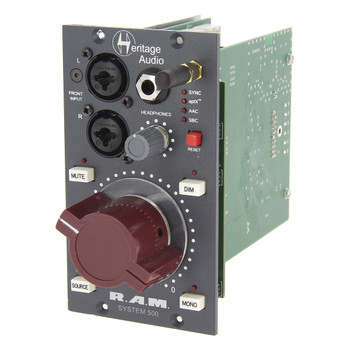Description
A-Range 500
The legendary A-Range® equalizer holds a unique place in audio history, with a stunningly musical sound that resulted from its all-discrete transistor circuitry and the use of inductors in the upper and lower mid bands. The A-Range® is a faithful re-creation of the original four band Trident A-Range® equalizer in a 500 module format, that will add the unique Trident signature to any programme material.
Introduction
The legendary A-Range® equaliser holds a unique place in audio history, with a stunningly musical sound that resulted from its all-discrete transistor circuitry and the use of inductors in the upper and lower mid bands. The A-Range® s a faithful re-creation of the original four band Trident A-Range® equaliser in a 500 module format, that will add the unique Trident signature to any programme material.
The mid frequency EQ sections are “peaking”, while the high and low frequency sections are “shelving”. A distinguishing feature of both the original A-Range® console and this module, is the use of faders for level adjustment, rather than rotary potentiometers. These faders feature a useful centre detent at mid travel to denote zero boost or cut of the selected frequency. The use of faders makes it very easy to see not only how much equalisation is being applied. Each band is rotary-switch-selectable to one of four frequencies, while individual push buttons engage the three high pass and three low pass filters. An LED peak level indicator is included to warn when levels get too high. The Line level input and output are balanced for maximum signal integrity & high output levels with minimum distortion.
The difference between shelving and peaking equalisers are as follows. A shelving equaliser boosts or cuts all frequencies equally, above or below a certain frequency, usually the point where it effectively reaches its “shelf” state. A “high shelf” EQ boosts or cuts high frequencies and a “low shelf” type boosts or cuts low frequencies. This type of circuit is very popular in hi-fi systems but is also actually highly musical when applied in a recording environment. In contrast, a peaking equaliser is one that, as its name implies, has a centre frequency that is boosted or attenuated more than others. The frequency range over which it reaches its peak and then falls down is known as the bandwidth (or “Q”). Because this type of design reaches a peak and then falls away, it is possible with this type of circuit to “home in” on particular frequencies and make adjustments without affecting those around them. This can be particularly useful when working with instruments such as bass guitars and snare drums. By incorporating both shelving and peaking equalisers into the design of the versatile A-Range®, it is possible to get the best of both types of design.
Specifications
- Input impedance: 10kohm balanced
- Common mode rejection: 70dB
- Equivalent input noise: -85dBu (unweighted, no boost or cut)
- Distortion: 0.05% (+4dBu output, 1kHz)
- Frequency response: 20Hz to 20kHz (-1dB)
- Boost / Cut range: +/-15dB (variable)
- Filter Q value: 1.3 (1 octave)
- Maximum input level: +22dBu
- Max output before clip: +28dBu (10k load)
- Nominal output level: +4dBu (electronically balanced)
- Output impedance: 100 ohm
- Output noise floor: -85dBu (typical, unweighted)
- Peak LED threshold: +16dBu
- I/O connections XLR: pin 2 +, pin 3 -, pin 1 ground
- Current requirement: 130mA (maximum) per rail










